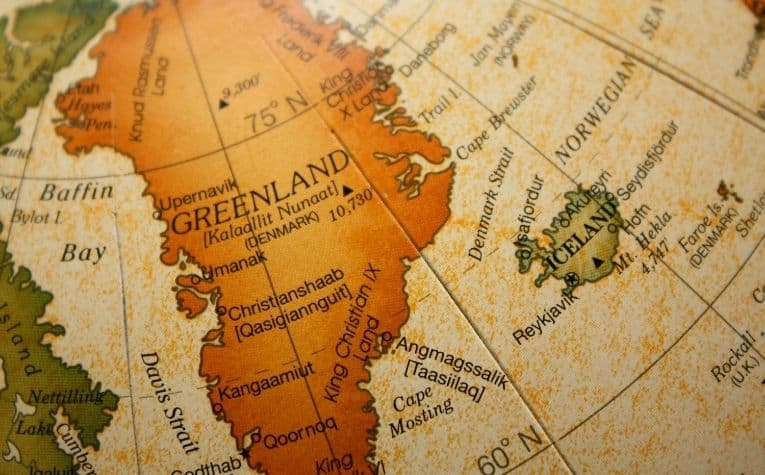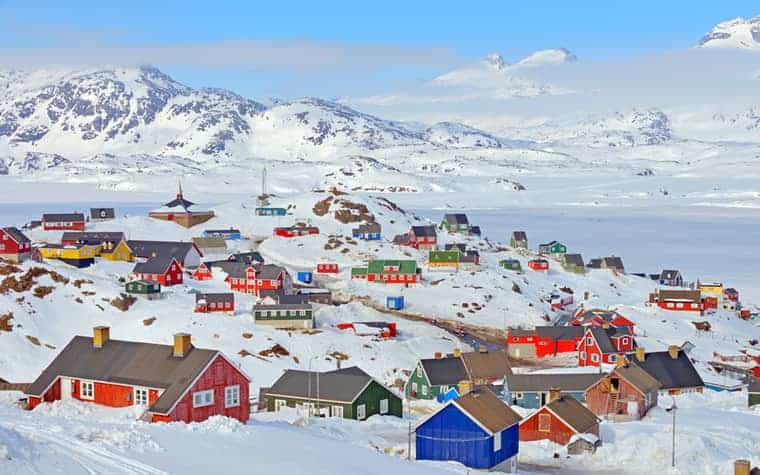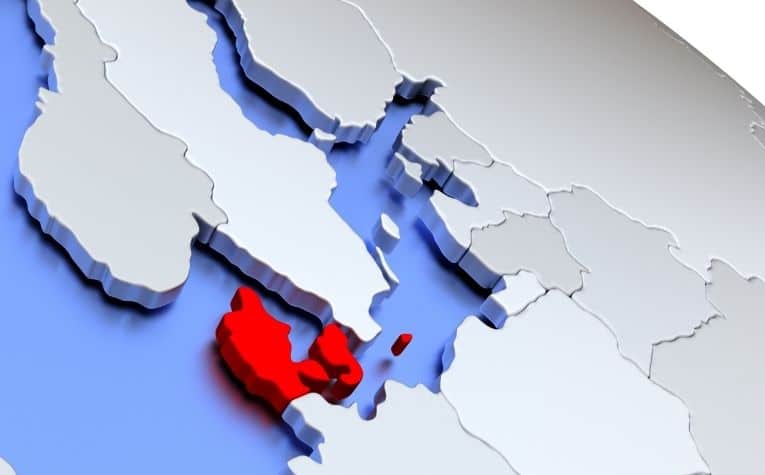Many people know that Greenland is the largest island in the world and that it is found at the top of the globe in between the North Atlantic and Arctic Oceans.
Greenland is also in the same area of the world as Scandinavia, so people naturally wonder if it is considered a Scandinavian country.
Greenland is not considered part of Scandinavia. In the narrow use of the name, “Scandinavia” refers to Norway, Sweden, and Denmark.
In the broader use of it, in addition to those three countries, “Scandinavia” also refers to Finland, Iceland, and the Faroe Islands.
It does not, however, refer to Greenland.
However, more explanation is required, because Greenland is presently an independent territory of Denmark, which is a Scandinavian country.
Also, see Why Do Some Scandinavians Look Asian? to learn more.

Greenland is part of North America
Greenland is considered part of the continent of North America, not Europe.
Scandinavian countries, in both the narrow and broad use of the name, are countries in northern Europe.
Greenland is considered part of the North American continent largely due to its proximity.
At its closest point, the island’s northwest corner is less than 20 miles from Canada, the northernmost country in North America.
To the east, Greenland is about 2,000 miles, across the Atlantic Ocean, from mainland Europe.
Its closest European neighbor is the island of Iceland, which is about 750 miles away.
Greenland has many similarities with Scandinavia: Greenland is geographically closer to North America.
However, politically and culturally, the island nation aligns more with Scandinavia and northern Europe.
It has less in common with the United States, Mexico, and several other North American countries.
This has been true historically and remains so in the present day.
However, there is one North American country that Greenland has a lot in common with and that is Canada, especially the region of northern Canada.
The two nations, which are both partially in the Arctic Circle, have similar ways of life because of their cooler climates.
As a result, they have similar plants, animals, and other natural resources.
Scandinavia is a unique region in the world. See Why is Scandinavia Less Populated? to learn more.

North America and Scandinavia’s Influence on Greenland
The history of Greenland includes North America and Scandinavia.
People from both continents have significantly impacted the island nation from its early history.
The first migrants to the island, who arrived around 2,500 B.C., were natives of present-day Alaska and Canada.
These early visitors never existed in large numbers on the island, however.
Some of the earliest explorers of Greenland may have left and returned home before settling.
Others may have tried to stay, but were unable to survive on the island and eventually died off. [1]
Other explorers likely visited the island in the following centuries, yet there is no evidence that European explorers visited the island prior to the 10th century A.D. [2]
It is likely that the first Europeans did not attempt to explore the vastness of the Atlantic Ocean so Greenland was not visited, but over the centuries sailors began to travel farther west.
Viking explorers: In the 10th century, Icelandic Vikings from northern Europe—known for their seafaring abilities—first established settlements on the southwest corner of Greenland.
Early settlements on the island were at the mercy of the climate and the weather.
Snow and ice limited the availability of certain resources on the island that were necessary for survival, like food, and made other resources more difficult to acquire.
One historian notes: “In the tenth century, colonies were founded in Greenland; there were Norsemen there for 500 years. Then they disappeared, probably because the settlers were wiped out by Eskimos pushed south by the advance of the ice.” [2]
Inuit settlements: Inuit people of Eskimo heritage, indigenous to Canada, yet found in certain regions of northern Europe, settled on Greenland in the 13th century.
Even when European settlers left the island or died off, the Inuit people remained. [3]
The Inuit were perhaps better prepared and more skilled to live in the frigid conditions that are found on the island.
Norway laid claim to the island from approximately the 13th to the 15th century, but its influence weakened when the Black Death struck Europe.
In the following centuries, as Europe continued to explore the east coast of present-day North America, Greenland was literally in the northern middle of these expeditions.
European explorers would use the island for its resources and for its proximity between the mainlands of two continents.
Greenland aligns with Scandinavia: Denmark-Norway, a multi-country union that existed from the 16th century to the 19th century, eventually claimed the island, citing previous explorations and earlier settlements as their right to do so.
In the 18th century, Denmark-Norway took a greater interest in the island and established trading posts along the coastline.
In the following centuries, the island was aligned with Denmark and experienced the blessings and challenges of that country’s political experiences.
In the 20th century, Germany invaded Denmark, which led the nation to align itself with the U.S. and Canada. [4]
After the Nazis were defeated, Denmark re-established jurisdiction over Greenland. In 1979, Greenland began to govern itself, though it remained a territory of Denmark.
Is Scandinavia Socialist or Capitalist? See Democratic Socialism in Scandinavia to learn more.

The relationship between Greenland and Denmark
Greenland and Denmark’s political connections have several aspects:
- Greenland does not have its own head of state, like completely autonomous nations have. Rather, Greenland’s head of state is whoever Denmark’s head of state is. Greenland does, however, have representation in the Danish political system, so governing bodies can take into account its values and concerns.
- Denmark’s head of state appoints a commissioner to Greenland, and the island nation elects two representatives to Denmark’s parliament, which numbers 179 in total. This relationship ensures that the best interests of both parties are considered.
- Greenland itself also has its own parliament of 31 members, headed by a premier, i.e. a leader. The premier, often the leader of the majority political party, is the one who appoints members. This body deals with local matters that concern the people of Greenland.
In 2009, Greenland gained independence in order to govern itself in areas like legal matters and with regard to the stewardship of its natural resources.
Greenlanders were also recognized as separate people under international law.
These steps help them establish a unique identity outside of their relationship with Denmark.
Greenland is still financially dependent on Denmark. However, through the stewardship of their natural resources, it is expected that their income will enable them to be independent of Denmark in the future.
For the time, the cordial partnership helps both countries. Greenlandic was declared the sole official language of Greenland in 2009.
Greenland and Iceland are in close proximity to one another. See Can You See Greenland from Iceland? to learn more.
Military ties of Greenland and Europe and North America
The United States and Denmark both have military bases in Greenland.
The Thule Air Base is the northernmost military base of the United States.
It was built post World War 2, from 1951 to 1953, by means of a massive engineering and construction effort that involved thousands of people.
The base is strategically located to strengthen America’s alliances in Europe.
It was also strategically placed for posturing with the U.S.S.R. during the Cold War.
The United States and Danish military personnel and contractors presently occupy the military base, in a cooperative effort. [5]
Servicemen and women run drills and maintain equipment, which can be challenging in a frigid climate, and carry out other tasks as directed.
The Island Between Continents
Though Greenland is technically part of the North American continent, it is clearly a nation whose history, culture, and way of life cannot be understood without knowing about its European influences.
The island lies between two continents and influences from both continents can be found on it.
Greenland’s challenging geography is clearly a central player in its early history, casting off would-be settlers.
Yet explorers eventually found ways to adapt to the environment, settle on the island, and build a civilization that continues today.
Early in the 21st century, the island nation began moving toward more independence, which is reminiscent of the time before Northern Americans and Europeans discovered it.
These modern events will secure Greenlanders’ unique identity and culture for years to come.
The islanders’ relationship with North America and Europe, however, will likely remain strong.
References:
[1] Source
[2] J.M. Roberts, A History of Europe, p.136-137.
[3] Source
[4] Source
[5] Source
